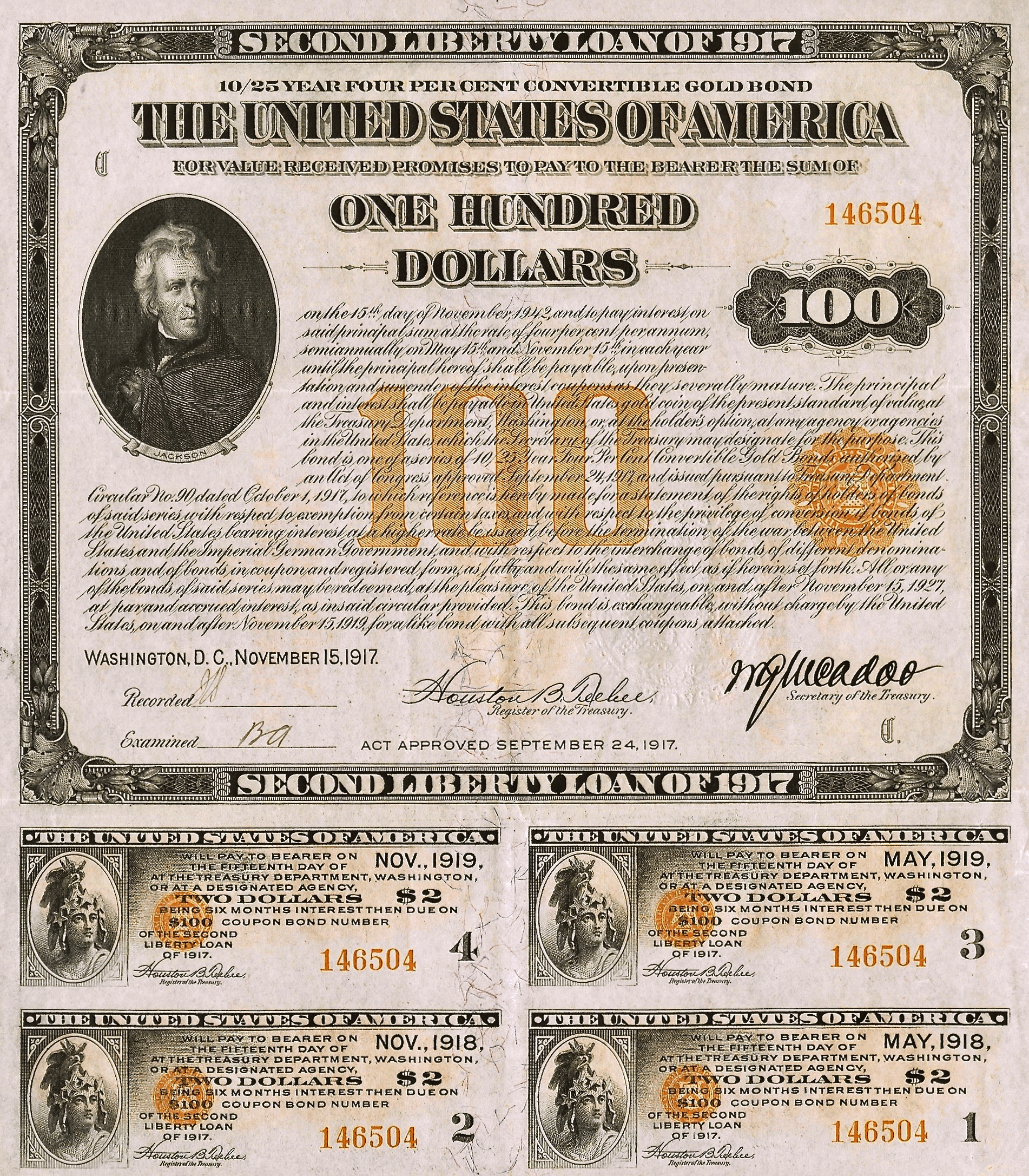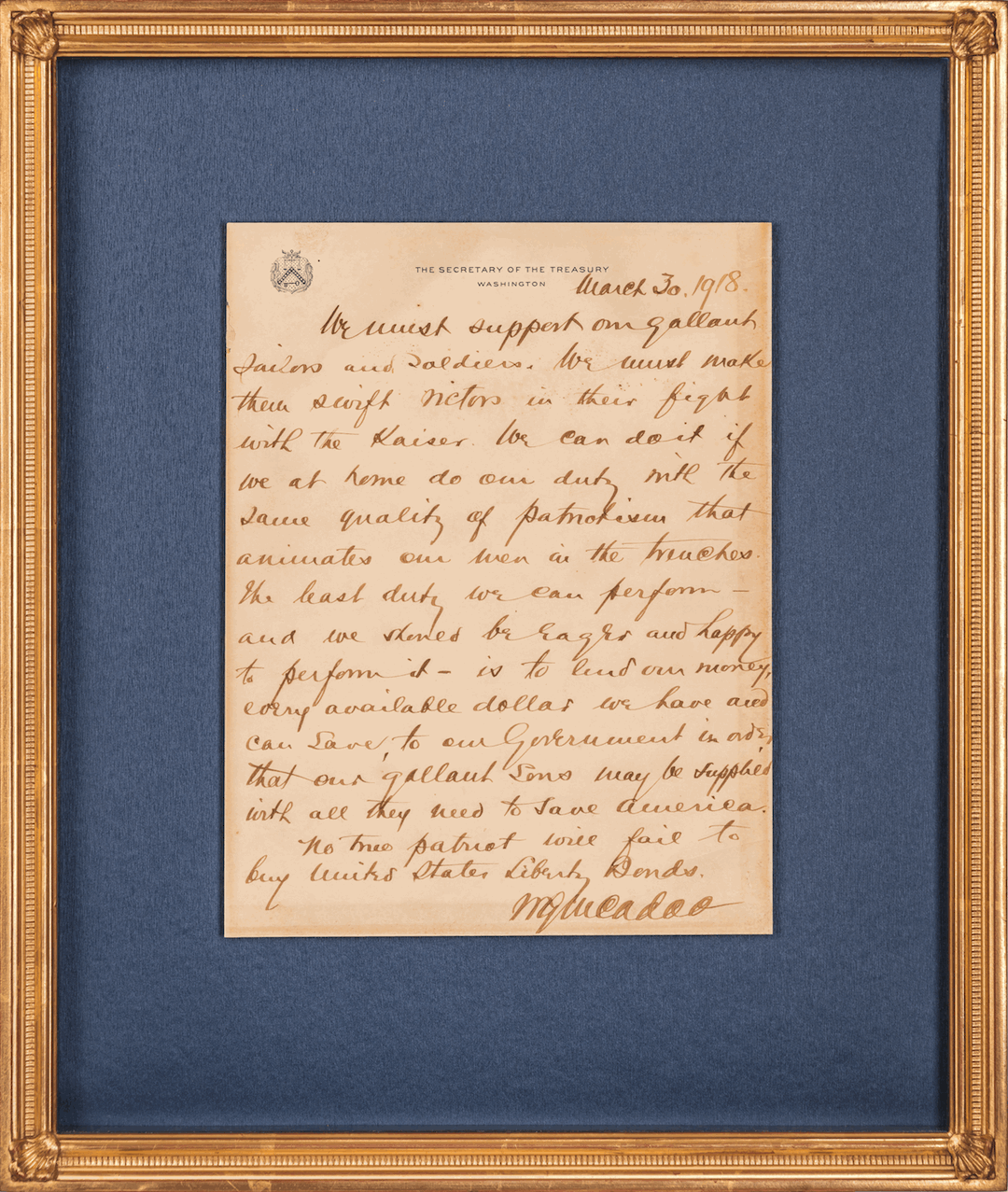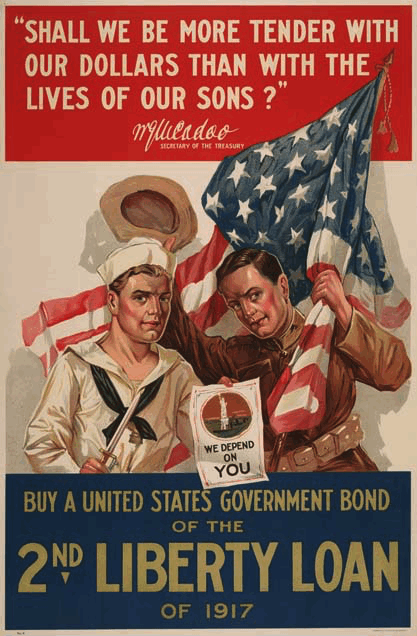The Liberty Loans (also known as Liberty Bonds) were issued between 1917-1919, and were used to finance America's participation in the First World War. Liberty Bonds were sold to banks, corporations, and to citizens. This was the first time in U.S. history whereby a substantial number of Americans would purchase bonds as both an investment and as a patriotic duty. William Gibbs McAdoo, then Secretary of the Treasury, was responsible for creating the program, which raised some $21.4 billion over five bond issues: the First, Second, Third, and Fourth Liberty Loans, along with a Victory Bond. Liberty Bonds were sold in denominations from fifty dollars to one hundred thousand, both in bearer and registered formats. Some 66 million individual bonds were sold; today, fewer than 400 examples are known to exist, and all but a dozen are either in $50 or $100 denominations.
The Liberty Loans represent the birth of modern debt issuance by the United States, and it is the Second Liberty Bond Act of 1917 that is the basis for the sale of Treasury bonds to this very day. The Herbstman Collection has the most complete collection of Liberty Loans known, along with President Woodrow Wilson's 1913 cabinet appointment of William Gibbs McAdoo as Secretary of the Treasury.


1917 $50 and $100 First Liberty Loans
3 ½% 30-year Coupon Bonds
Original Issuance: $1.98 Billion (Issuance totals are for the entire loan series)
This series carried a 3.5% interest rate. It came in a booklet form with sixty interest coupons attached. The portrait of Washington, which was often used by the Bureau of Engraving and Printing (BEP), was engraved by Charles Burt, and the engraving of Jefferson was by Alfred Sealey.
Fewer than thirty examples known of the $50 bond, fewer than ten of the $100


1917 $50 and $100 First Converted Liberty Loans
4% 30-year, Short Coupon
Original Issuance: $1.98 Billion
This series carried a 4% interest rate. As potential future interest rate increases were a consideration in the sale of these bonds, a conversion provision was part of the bond terms, allowing for the option to exchange a 3.5% bond for a higher rate later issued. This bond was a "short" or temporary security, which would be exchanged after the first two years of interest for a long format bond.
Two of three known short coupon bonds within the issue

1917 $100 First Converted Liberty Loan
4% 30-year, Registered Bond
Original Issuance: $1.98 Billion
The second of three known examples from the entire First 4% Conversion, and the only known registered bond within the issue.

1917 $50 First Converted Liberty Loan
4% 30-year, Long Coupon
Original Issuance: $1.98 Billion
This series carried a 4% interest rate. This bond began with coupon #5.
The third of three known examples from the entire First 4% Conversion, and the only known long coupon bond within the issue


1917 $50 and $100 Second Liberty Loans
4% 30-year, Short Coupon
Original Issuance: $3.8 Billion
This series carried a 4% interest rate. These examples are "short" or temporary coupon bonds, bearing four interest payments. A bond would then be exchanged for a long format security beginning with coupon #5.
The $50 is of six known examples, the $100 one of two

1917 $50 Second Liberty Loan
4% 30-year, Long Coupon
Original Issuance: $3.8 Billion
This series carried a 4% interest rate. This was a long format coupon bond, and began with coupon #5.
One of two known examples
.jpeg)
1918 $50 First Liberty Loan, Converted
4 ¼% 29-year, Short Coupon
Original Issuance: $1.98 Billion
This series carried a 4.25% interest rate. It was the second time the First Liberty Loan issue was converted to a higher interest rate.
The only known example of a short coupon bond from this issue


1918 $50 and $100 First Liberty Loans, Converted
4 ¼% 29-year, Long Coupon
Original Issuance: $1.98 Billion
Fewer than ten known examples of either denomination


1918 $50 and $100 Second Liberty Loans, Converted
4 ¼% 24-year, Short Coupon
Original Issuance: $3.8 Billion
This series carried a 4.25% interest rate, which was a conversion from the 4% Second Liberty Loan issue.
The short coupon bonds would be exchanged for long format issues.
The $50 Denomination is the only known example, the $100 is one of four


1918 $50 and $100 Third Liberty Loans
4 ¼% 10-year, Long Coupon
Original Issuance: $4.175 Billion
This series carried a 4 ¼% interest rate, and began with coupon #5.
These example is a very rare complete bonds, the $50 one of eleven known, the $100 one of ten
An example of this Liberty Loan has been gifted to the American Numismatic Association Edward C. Rochette Money Museum by the JIHMC


1918 $50 and $100 Second Liberty Loans, Converted
4 ¼% 24-year, Long Coupon
Original Issuance: $3.8 Billion
This series carried a 4.25% interest rate, which was a conversion from the 4% Second Liberty Loan.
This security was a long format bond, and it began with coupon #5.
The $50 is of around twelve known examples, the $100 one of ten


1918 $50 and $100 Third Liberty Loans
4 ¼% 10-year, Short Coupon
Original Issuance: $4.175 Billion
This series carried a 4 ¼% interest rate.
These "short" or temporary coupon bonds, bearing four interest payments, would be exchanged for a long format bond beginning with coupon #5.
Fewer than twenty known examples of each denomination


1918 $50 and $100 Fourth Liberty Loans
4 ¼% 20-year, Short Coupon
Original Issuance: $6.96 Billion
This series carried a 4 ¼% interest rate.
Fewer than ten known examples of each denomination

1918 $50 Fourth Liberty Loan
4 ¼% 20-year, Long Coupon
Original Issuance: $6.96 Billion
This series carried a 4 ¼% interest rate, and would have started with coupon #5. The Fourth Liberty Loans (long format) are the most commonly found Treasury Bonds of any issue within numismatics. This series has also the distinction of being the only federal bond issue within American history to default on its terms. The Fourth Liberty Loan was to be payable, "in United States gold coin of the present standard of value." However, in 1933 Congress passed House Joint Resolution 192 which suspended payment in gold, a year before the Fourth Liberty Loan was to be called. Despite a legal challenge to the default, (wherein the Supreme Court acknowledged a violation of the 14th Amendment), the Fourth Liberty Loan was not redeemed at the original terms of its issuance. The high court felt that to pay bondholders at a 1918 gold value would be an unjust enrichment.
This example is a very rare complete bond. Between fifty to one hundred examples likely exist of this denomination

1918 $100 Fourth Liberty Loan
4 ¼% 20-year, Long Coupon
Original Issuance: $6.96 Billion
This example is a very rare complete bond. About twenty-five known examples
An example of this Liberty Loan has been gifted to the National WWI Museum and Memorial by the JIHMC

1918 $1000 Fourth Liberty Loan
4 ¼% 20-year, Short Coupon
Original Issuance: $6.96 Billion
This bond is one of three known $1000 denominated Liberty Loans, and the only known example of a $1000 short coupon Liberty Loan


1918 $50 and $100 Fourth Liberty Loans
4 ¼% 20-year, Registered Bonds
Original Issuance: $6.96 Billion
The $50 is one of six known registered bonds, the $100 one of two


1919 $50 and $100 Victory Liberty Loans
4 ¾% 4-year Note
Original Issuance: $4.5 Billion
The fifth issue in the series, (also known as a Victory Bond), this note carried a 4 ¾ % interest rate and was a Treasury Note.
The $50 has than fifteen known examples, the $100 fewer than four


1920 $50 Second Liberty Loan Coupons
4 ¼% Conversion Special Interest Coupons
The 4% Second Liberty Loan was convertible, at the owner's request, into a 4 ¼% bond. This conversion provision existed for both the First and Second Liberty Loan issues. When the 4% Second "temporary" Liberty Loan bonds were submitted to the Treasury, these Special Interest Coupons would accompany the new "permanent" or "long- format" 4 ¼% bond. These coupons made up for the interest periods not covered by the newer "permanent" Liberty Loan received. The perforations seem to be a unique feature of the Special Interest Coupons, as the Treasury never otherwise perforated interest coupons.
The Herbstman Collection thanks Dr. Franklin Noll of the BEP for his assistance in cataloguing these coupons.

1913 Appointment of Secretary of the Treasury to William Gibbs McAdoo
Signed by President Woodrow Wilson
Countersigned by Secretary of State William Jennings Bryan
Previously on loan to the Federal Reserve Bank of New York

1918 Excerpt From The Third Liberty Loan Campaign
Handwritten by Treasury Secretary William Gibbs McAdoo
These remarks, dated March 30, were part of the Secretary's campaign to sell the Third Liberty Loan.
This speech is found in publications from the U.S. Treasury Department, Bureau of Publicity.
We must support our gallant sailors and soldiers. We must make them swift victors in their fight with the Kaiser. We can do it if we at home do our duty with the same quality of patriotism that animates our men in the trenches. The least duty we can perform- and we should be eager and happy to perform it- is lend our money, every available dollar we have or can save, to our Government in order that our gallant sons may be supplied with all they need to save America. No true patriot will fail to buy United States Liberty Bonds.
Previously on loan to the Federal Reserve Bank of New York
Copyright The Joe I. Herbstman Memorial Collection of American Finance
All Rights Reserved


